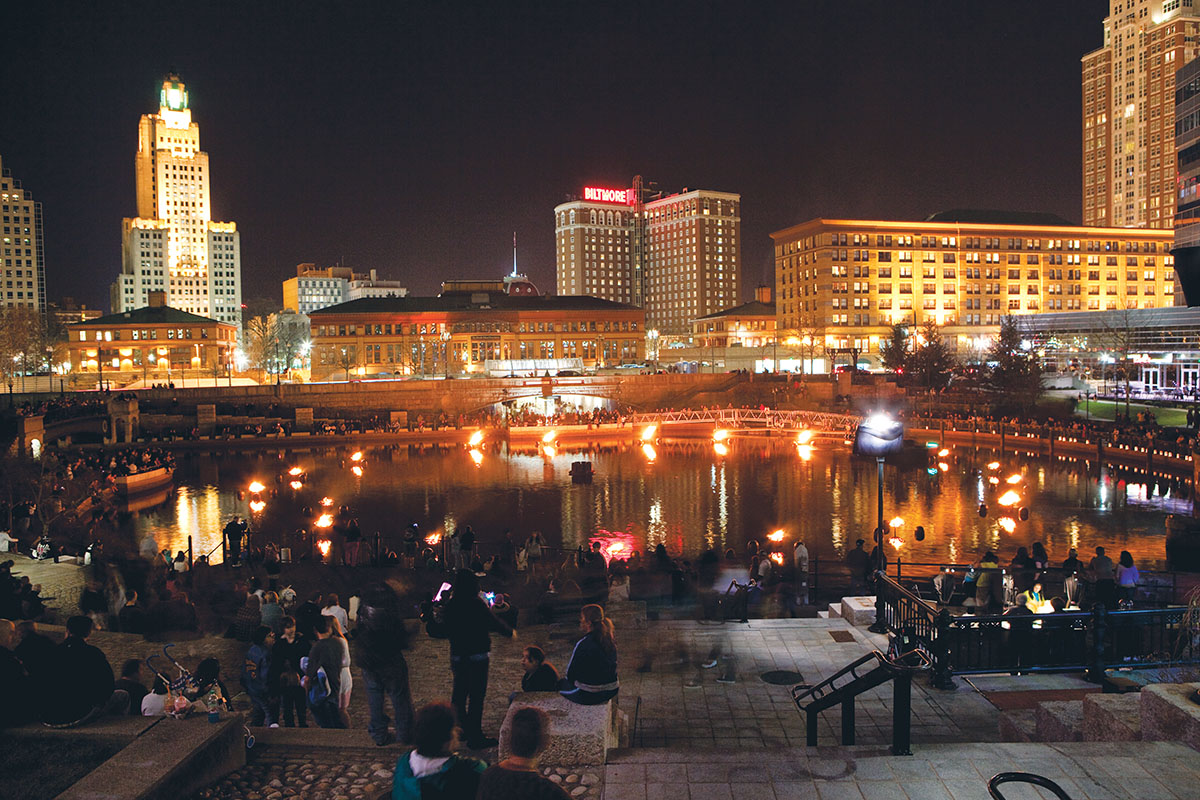The $500 Weekend: Providence, Rhode Island

Photograph by Kate Kelley.
Peek at any account of Providence back in its not-so-golden era, and it all sounds perfectly dreadful. But over the years, organized crime and a seedy reputation have given way to culinary sophistication, architectural character, and bonfires beloved by locals and visitors alike (see below).
GETTING THERE By May, the first leg of the 50-mile drive from Boston to Providence gets clogged with weekending Cape-goers. Forgo blaring horns for the soothing thrum of the cheaper, speedier commuter rail ($7.75 each way).
SLEEPING Souped-up chain hotels in this self-dubbed Renaissance City can feel as pricey as a minor Da Vinci, while the abundant B&Bs err on the side of achingly quaint (read: ultra-shabby chic). Splitting the difference, the city’s newish Hampton Inn, installed into the grand surrounds of a former monastery (more recently a bank), combines elegance with period charm and downtown convenience ($129 a night).
EATING Once upon a time, Providence’s best fine-dining option was…Boston. Then, in 1980, Al Forno opened. The restaurant practically invented grilled pizza, and its cultlike popularity shows no sign of receding. While Al Forno’s wood-charred pies are still a solid option, epicureans today prefer Bacaro, Farmstead’s La Laiterie, and New Rivers. Where to make a reservation? Tough call. The pastas at New Rivers are transcendent, whereas La Laiterie’s grilled pimiento cheese sandwich with house-smoked bacon ($12) is a gooey, glorious dream. But we’ll give the edge to Bacaro’s tapas-style Italian fare, expertly crafted by Al Forno alum Brian Kingsford. You can’t go wrong with an order of spicy gratin of oysters ($7), followed by crispy chicken over pasta fagioli ($28) and the cracker-thin grilled pizza Margherita ($19).
PLAYING Lumbering, space-age microwaves, circa 1960! A 1920s tenement kitchen! An original menu from Lincoln’s dessert-heavy inauguration dinner! Charting a dizzying course through the centuries of eating and cooking, the Culinary Arts Museum ($7) at Johnson & Wales University is the most underrated attraction in the state, even if you’re not gastro-obsessed. One of the top applied-arts schools in the country, the Rhode Island School of Design also has an on-site Museum of Art ($10) with plenty of Manets, Monets, and ornate medieval mosaics worth eyeballing – but the real gems are new works by promising RISD students. And then there’s WaterFire, a 15-year-old warm-weather Providence ritual that kicks off this month. An award-winning public sculpture by Barnaby Evans makes this spectacle possible: On designated evenings, 100 wood bonfires float downriver through historic Providence via torch-lit vessels. Shops stay open late. Citizens rejoice. It’s a marvel to behold. (For the 2010 schedule, go to waterfire.org.)
BROWSING The rejuvenated Downcity district is poised to steal Federal Hill’s crown as Providence’s reigning shopping mecca, with well-curated urban boutiques filling out industrial lofts. Among the best: Homestyle, for modern housewares; Clover, for high-end designer garments; Heir, for oddball modernist antiques; and Eno, a wine store whose selection – displayed in full walls of vintage mail slots – rivals that of any New England vino vendor. For an extra treat, decamp to the charming Fox Point neighborhood for the quirky Curatorium, a one-stop shop for unique-gift procurement.
OBSERVING THE LOCALS Mismatched antique chairs, retro desserts, and boozy coffee drinks that billow with whipped cream (average price: $12) set the funky vibe of L’Elizabeth, as does the chatterbox of a hostess, baker, and mixologist, Ruth, who’s been running the cafe since the mid-’70s. At Cafe Noir, scenesters reenact episodes of Sex and the City – sans irony – but the bar snacks and martinis ($8 each) are mighty tasty.
For more regional getaways, go to bostonmagazine.com/new_england_travel.